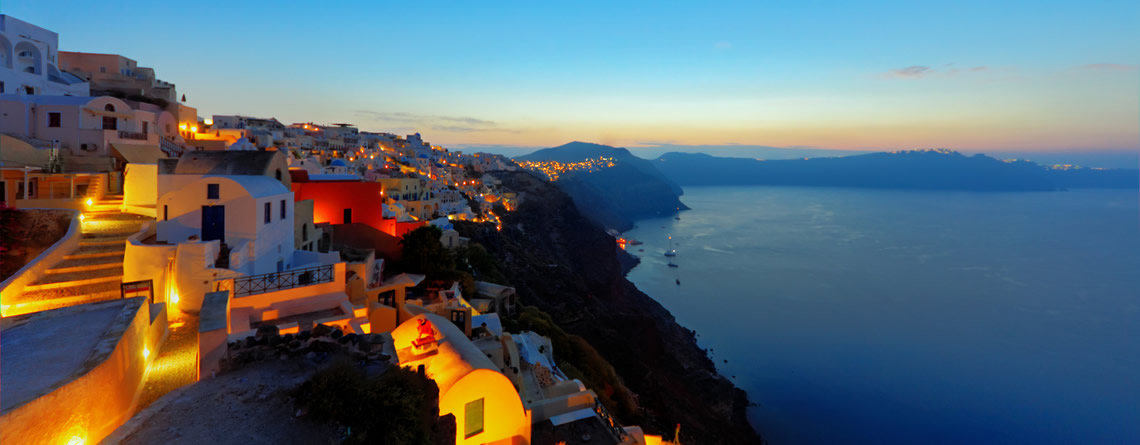
Until 1630 BC, Santorini – which called Kallisti – was just another conical, volcanic island, with a Minoan town on the south shore. The Centre of the island collapsed into the now-empty caldera when one of the most violent known eruptions of its type caused. The sea rushed in to fill it, leaving only the present, crescent-shaped island above water. The attending earthquake triggered a tsunami which accelerated the demise of Minoan Crete.
The island was eventually resettled as ancient Thera, but inhabitants had to contend with repeated tremors and fresh eruptions, which created two islets in the caldera.
Many reasons made this island famous worldwide. There is a talk about the connection between Thira and mythical Atlantis. Also Jules Verne made Santorini famous with its books “Twenty Thousand Leagues under the Sea” and “The mysterious island” where captain Nemo and his crew watch the volcano eruption. He was one of the visitors and scientists that came to Thira during the eruptions of 1866 – 1870 and wrote the well-known book just after it. It is really the mysterious island, the volcano rules; the caldera view is the most breathtaking one on the planet!
Santorini is really best approached by sea; as your arriving craft maneuvers over the impossibly midnight blue waters of the caldera, the sheer lava cliffs of the caldera lip, layered in varicolored rock, loom overhead, with white houses on top like a dusting of snow.
It’s one of the spectacles of the Mediterranean, as is the reverse practice of staring out over the caldera waters from up top – something not lost on the strangely assorted clientele of honeymooners, cruise-ship patrons and backpackers.
Fantastic, fabulous Santorini deserves all the superlatives. Even the most jaded traveler succumbs to the awesome drama of this surreal landscape, relic of what was probably the biggest eruption in recorded history. That you share the experience with hordes of other visitors is inevitable. Embrace it all. The caldera and its vast curtain wall of multicolored cliffs are truly awesome. If you want to experience the full dramatic impact it’s worth arriving by a slower ferry with open decks, rather than by enclosed catamaran or hydrofoil.
Santorini is famous for its spectacular sunsets. The village of Oia on the northern tip of the island is a hugely popular sunset viewing site because there is an uninterrupted view of the sun as it finally sinks below the horizon. From farther south down the caldera edge, the last of the setting sun can be obscured by the islands of Nea Kameni and Thirasia. You can enjoy most of the sunset from almost anywhere along the rim of the caldera, especially if you want to avoid the sometimes feverish crush at Oia.
The unique caldera, the energy and the beauty of the island are the most important reasons for being ranked as the top island in Europe and one of the once in a life time must see destinations of the world.
When to go
The Cyclades are most enjoyable in late spring – when the landscape is still green, the sea has warmed up to feasible swimming temperatures, but the crowds have yet to descend – and early autumn, when the summer hordes have departed and the sea is at its warmest.
Getting there
By Air
Santorini (Thira) National Airport is an airport in Santorini/Thira, Greece (IATA: JTR, ICAO: LGSR), located north of the village of Kamari. There are regular flights every day from Athens by Olympic Air and Aegean Airlines. Flight duration from Athens to Santorini is about 35 minutes. During summer, Sky Express connects Santorini with other popular islands such as Crete (Heraklion), Rhodes and Mykonos.
From May till October charter airlines fly directly to Santorini from many European airports.
- Air Berlin flies from Berlin Tegel (TXL), Düsseldorf (DUS) , Hamburg (HAM), Nuremberg (NUE) and Vienna (VIE)
- Condor flies from Dusseldorf (DUS), Stuttgart (STR), Frankfurt (FRA), Munich (MUC), Hamburg (HAM)
- Easy Jet flies from London Gatwick (LGW) and Milan Malpensa (MXP)
- Edelweiss Air flies from Zurich (ZRH)
- Germanwings flies from Cologne/Bonn (CGN), Munich (MUC) and Stuttgart (STR)
- Jetairfly flies from Brussels (BRU)
- Meridiana flies from Milan Malpensa (MXP)
- Norwegian flies from Copenhagen (CPH), Oslo (OSL) and Stockholm (ARN)
- ThomasCook flies from London Gatwick (LGW), Manchester (MAN) and Brussels (BRU)
- Thompson flies from Manchester (MAN)
- Transavia flies from Amsterdam (AMS)
By Sea
Take the ferry from Piraeus past Paros and Naxos to the new port on Santorini. There is also daily connection between Heraklion (Crete) and Santorini during high season.
If you prefer sea, your best bet is high-speed catamarans. The trip from Piraeus to Santorini takes 4.5hrs with a high speed ferry.
Getting around
From Santorini airport (7km from town near the east coast), KTEL buses provide regular shuttles to the main bus station in Fira. All ferries and catamarans dock at Athiniós port, 11km from town; whereas most cruise ships heave to at Skála Firás and transfer passengers by launch to the 580 steps climbing to Fira town (walk, or hire a donkey). Failing that, a frequent cable-car whisks you up the Cliffside.
Buses (and taxis) meet all ferries and then cart passengers through an ever-rising series of S-bends to the capital, Fira, which fringes the edge of the cliffs like a snowy cornice.